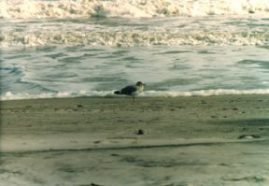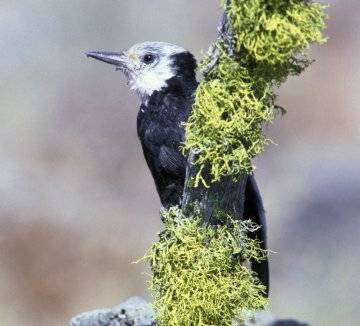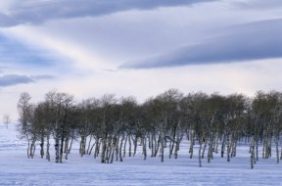Sounds and silence
Protecting nature's sounds and just taking the time to listen can enrich our lives.
By Emily Sohn
Shhhhhh.
You already have to deal with your teachers telling you to settle down, your parents asking you to be quiet, and your big brothers and sisters shooing you away.
Now, some scientists are trying to get all of us to shut up—at least once in a while. We may be surprised by what we hear, they say, when we stop and listen. Paying attention to natural sounds could also help us do a better job of keeping our planet healthy.
“Natural sounds are an important resource,” says Chris Shaver of the National Park Service in Denver, Colo.
 |
|
A seashore soundscape may include the roar of surf and the cries of birds.
|
| I. Peterson |
People often visit parks to find a sense of peace and solitude they can’t get at home. Animals use sounds to communicate with one another. And, just as cutting down trees threatens the wilderness, so also does interrupting the normal symphony of sounds in our surroundings, Shaver says.
“There ought to be somewhere in every park where people can go and know they are hearing natural sounds,” she says. “Just like there are ‘no smoking’ zones, there should be ‘no noise’ zones.”
Protecting the sounds of nature is a big part of what Shaver does. As chief of the Air Resources Division of the National Park Service, she is leading a major effort to study and preserve natural soundscapes in a variety of parks around the United States. A soundscape is the sum of the noises that make up a particular environment: chirping birds, screeching crickets, buzzing bees, rustling leaves, or whatever else the location and season present.
Animal noises
Even if tourists don’t notice the noises of nature, lots of animals do, Shaver says. “Animals use sounds to communicate with each other in ways we don’t even hear or understand,” she says.
From birds to bison and crickets to cuckoos, all sorts of creatures use sound to find mates, hunt prey, hide from predators, or track down their babies, among other important tasks.
If you’ve ever played quietly outside in the woods, you’ve probably noticed a hum of activity happening around you. As soon as an airplane flies overhead, a car drives by, or a snowmobile zooms past, though, the chirps and squawks can suddenly disappear. There’s just an uncomfortable, unnatural silence.
It can sometimes take more than half an hour before the normal sounds come back completely, Shaver says.
Such a delay can spell the difference between life and death for some animals, suggests Bernie Krause. Krause is a musician and a bioacoustician who studies animal sounds.
 |
|
Bird sounds, like those of the rare white-headed woodpecker, enliven a wooded soundscape.
|
| U.S. Fish & Wildlife Service |
When all the animals are speaking together, he theorizes, they are safe because it’s hard for predators to figure out who is where. The first one to open its mouth after a disturbance, though, is as good as gone.
At the same time, some animals get used to noise. They already put up with the rumble and crack of thunder. Some birds live at airports and pay no attention to planes taking off or landing. There’s even a bird sanctuary within range of the roar of occasional space shuttle launches at Cape Canaveral in Florida.
Plane disturbances
Airplanes are the biggest concern for Shaver and her colleagues. So many of the loud, hulking machines fly back and forth across the country every day, it’s nearly impossible to go anywhere without hearing one go by at some point.
“We have a map in the office showing flights over parks,” she says. “There are very few places you could stick a finger where there isn’t a flight path.”
The National Park Service can’t do anything about commercial flights. Instead, the staff is focusing on easing the impact of tourist flights in small airplanes or helicopters. Air tours are popular at Grand Canyon National Park and Hawai’i Volcanoes National Park, where tens of thousands of people pay to see the views from above every year.
To understand the impact of air tours and other human disturbances on park ecosystems, the Park Service is racing to record sounds from natural lands in a number of states, including Utah, Alaska, and Hawaii.
“We’re trying to get to parks as quickly as we can to get baseline data before air tours arrive,” says bioacoustician Skip Ambrose, who works for the National Park Service in Fort Collins, Colo.
Ambrose spends much of his time in the field, recording sounds. Since the soundscape projects are fairly new, the researchers first need to figure out what is out there and how loud it all is. So, after collecting sounds, the information goes into a computer to make a sort of library of natural and manmade sounds.
Ambrose is also working to put natural soundscapes on the Internet. Some parks have web-cams that show live pictures of certain places. Ambrose is helping design a sound-cam for the Smoky Mountains National Park that would be regularly updated with new sounds from a given setting. Net surfers anywhere in the world would be able to visit the site to find out what they would hear if they were in the mountains at that very moment.
Recording soundscapes, Ambrose hopes, will help people recognize and appreciate what we are losing, before it’s too late. “Some people think National Parks are so quiet,” he says. “It’s not true. If you go to a park, sit down, and listen, you’ll hear man-made noises way more than you think you will. It’s happened so gradually, people don’t realize what we’ve lost.”
Time to listen
Animals aren’t the only reason to care about sounds, says radio producer Jim Metzner. A resident of Ulster County, New York, Metzner has been listening to, studying, and recording sounds for almost 30 years.
“There are sounds that really enrich our lives, almost like a kind of food,” he says. Among his favorites, he lists a babbling stream near his home, the hum of the city from a rooftop on a summer night, and the voices of his dearest friends, including some who have passed away.
 |
|
Wind moaning through bare trees and snow muffling natural sounds gives a winter soundscape its own distinctive qualities.
|
Taking the time to listen, Metzner says, can teach us to make sense of the constant bombardment of noises around us. Every time you listen, he adds, there’s something new to learn. “The whole paradox of listening is the tacit admission that you don’t know something,” he says. “If you knew, why would you listen?”
Even if you’ve already heard something 100 times, you’ll probably hear something new on the 101st, Metzner says, if you pay attention.
Metzner recommends that kids use a little tape recorder to start a sound diary of their own. “One of the great sounds are sounds of parents and grandparents telling their stories,” he says. Recordings are one way to keep a time capsule of those memories—one that you can come back to for the rest of your life.
You might even want to start your own wilderness sound diary to see how the world around you changes through the years. You might be surprised at what you find. “I have a daughter who complains that the crickets are too loud,” Shaver says. “I tell her it used to be the freeway, honey. We need to have children understand that crickets are good.”
Next time you go outside, give it a shot. Close your eyes. And shut up. You might just find a whole other world out there—if you’re willing to listen.
Going Deeper:
News Detective: Emily’s Favorite Sounds
The Nature Sounds Society (www.naturesounds.org) suggests 10 simple ways in which to enjoy natural sound. Here are some of these activities:
- Stop. Listen to what’s around you. Now close your eyes. Do you hear other sounds? Do you hear more with your eyes closed?
- Walk and listen. Do you hear your footsteps? Do you hear your clothes rustle? Can you walk without making any sound?
- Try to hear the wind’s sound blowing through different plants.
- Find a stream or waterfall and listen carefully with your eyes shut until the sound separates into single notes.
- How does the shape of the land affect the way sound travels to your ears? Where is the source of each sound? Are there any echoes? What is the closest sound you hear?







